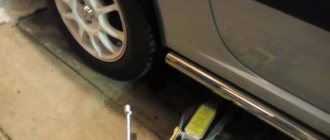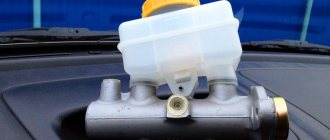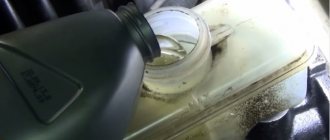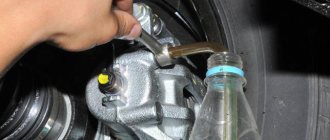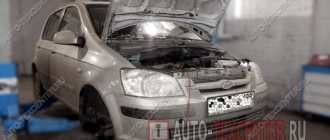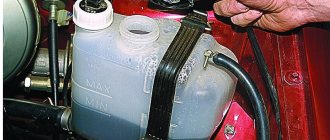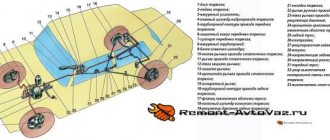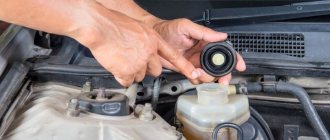When novice motorists come to me for advice on how to best care for their car, I immediately explain two things. If you want to feel safe, then first of all you need to take care of the full operation of the engine and the proper condition of the brake system.
If the engine breaks down, the car simply won’t move, but with the brakes everything is much more complicated. The car will be able to start and even drive all the way, but it will not be possible to brake at the right moment.
Since hardly anyone wants to get into an accident, it’s worth talking not even about filling the brake fluid, but about how much brake fluid is needed to replace the old compound with a new one.
The lack of lubricant in the system will make the brakes inoperable, which will also inevitably lead to an accident. So, this is the topic of my note today, and we will talk about the procedure in more detail later.
Under what circumstances is it necessary to replace the brake fluid?
To understand how much brake fluid may be required to replace consumables in the system, you need to answer one simple question - when does the need for such a procedure arise.
The fact is that many motorists do not read the recommendations in the car service book, although this is necessary. As a result, the driver does not pay attention to obvious signs of deterioration in the condition of the braking system.
The vast majority of motorists follow the old and, in their opinion, proven scheme - they simply top up the brake fluid as needed.
In fact, you can't do that. I advise experienced mechanics in this matter to focus on the indicators on the dashboard, where there is a corresponding symbol. If the level has dropped to a minimum level, then it is time to take serious measures.
Of course, you can simply add fluid, but after this procedure you will need to perform a full check of the serviceability of the brake system.
Brake fluid cannot simply decrease. If the level has decreased, it means that a leak has formed somewhere or a problem has arisen in the operation of the main brake cylinder. It happens that the substance is supplied unevenly to the wheels.
Stages of work
Professionals use a special installation to replace the TJ, but at home you can do without it. The essence of the process is to drain the old substance from each brake caliper through a special fitting, making sure that there is no air in the reservoir. Process steps:
- We look for the cylinder where the brake fluid reservoir is located and remove the cap from it.
- Using a syringe, pump out the old liquid into a plastic bottle.
- Before we fill in a new TZ.
- Jack up the car and remove the wheel.
- Remove the protective cap from the rear fitting valve.
- We put a transparent hose on the fitting, place its other end in a bottle into which the old liquid was drained.
- Loosen the fitting nut with a wrench and quickly return it to the reverse position. When the nut is soured and cannot be touched, it is necessary to knock it down and continue replacing.
- The next step requires an assistant to sit behind the wheel and apply and release the brake several times. 4-5 times will be enough, and the last time you should press all the way and not let go. At this time, at a signal, you need to loosen the nut and after a couple of seconds return it to its original position. Only then can you release the brake pedal.
- It is necessary to perform these manipulations on each wheel 6–7 times, if you have patience, then more is better.
- Check the presence of fluid; when the level is below about 0, add more. At the end, press the pedal again and if it does not sag, then the replacement was successful.
Replacement and pumping
Adviсe:
- Please note that during operations the car must be turned off; to be sure, remove the key from the ignition;
- the bleeding process should begin with the rear left wheel , then move to the right rear wheel, then the left front and front right;
- pump the first fitting until all the old fluid comes out. You can easily distinguish it from a new one by its color. We bleed the other fittings as usual;
- Make sure that the tank is not empty, otherwise you will take in air. When bubbles are noticed when draining the used substance, pump until they disappear altogether.
In what situations do experts recommend bleeding the entire brake system of a car:
- for a large amount of time there is a violation of control (the car suddenly drives in different directions);
- the substance was replaced not at the service center, but independently, by an inexperienced driver;
- pressing the brake pedal, you feel that it is too soft;
- The vehicle's brake system has recently been repaired.
Average volume of brake fluid in a car
Replacing fluid in the brake system can be planned, or it can be an emergency. Usually, if repairs to this important part of the car begin, the substance is completely drained. It is highly not recommended to re-fill the TJ into the system, since it has already lost all its working qualities. The optimal solution would be to purchase a new composition.
Many novice drivers are interested in how much brake fluid can be in a regular passenger vehicle. A lot depends on additional equipment (for example, ABS), but usually no more than 550 - 1000 ml. In other words, you don’t need a large container to drain the waste substance.
Self-replacement without assistants
Usually they buy TJ with a capacity of 1 liter. When replacing for passenger cars, 0.55 liters is usually used, regardless of the size of the car, cross-country ability, or the presence of ABS. The most commonly used grade is DOT-4.
This is the most popular product. They change it as a result of its high hygroscopicity. DOT-4 actively absorbs moisture from the air, and therefore loses its characteristics.
TJ should not be stored in an open container for a long time; it retains its quality for only two years! Before replacing, first install the car on an inspection hole or overpass. There must be free access to the place to drain the waste material and then fill the tank. You need easy access to the brake cylinders of four wheels.
What does the car need - topping up or completely replacing the brake fluid?
Before proceeding to active actions, the driver should clearly understand what he will do - just longer TJ or he will need to completely change the substance.
The first procedure is simpler, since it is enough to add liquid, and then make sure that there is enough of it for the entire system to fully operate. The second option is more inconvenient, since you will have to completely drain the brake fluid, flush the system and fill in a new compound.
There are several criteria to accurately answer this question, namely:
- the car has already covered 50-60 thousand km on liquid alone;
- The car was used for two to three years.
Actually, these two factors are enough to make a decision to replace the substance. The fact is that over the past time, the TJ has already absorbed a lot of water and has completely or partially lost its technical properties.
An exception may be a situation where the car has been idle for a long time, or has been used too intensively (up to 80-100 thousand km per year). Here only refilling of the substance is possible.
Why change the TZ in the system
The compounds used for proper operation of the machine must be completely replaced every 24-36 months. This measure is justified by the fact that the properties of liquids are lost over time. If we talk about fuel fluid, then the “ability” to absorb moisture, for example, during a prolonged start-up or during intense operation of the hydraulic system, contributes to its boiling. In addition, excess water provokes corrosion of the entire system.
Range of brake fluids
Update (partial/full) of the TJ is required:
- on the recommendation of the car manufacturer;
- in emergency situations (broken hoses, etc.);
- after replacing the brake system or its components;
- in case of presence of moisture inside the system;
- if air gets into it.
What factors influence the need to replace the diesel fuel?
There are a number of other points that may influence the decision to replace. For example, if a driver drives a vehicle too aggressively and prefers a sporty style, then replacing the brake fluid will be required much more often.
The issue is similar with the specification and type of TJ. The better the quality of the product, the longer it will retain its technical parameters. For example, the popular brake fluid DOT 4 is designed for 50-60 thousand km.
Mechanics advise updating such a substance with the specified regularity, or after repairs have been carried out. Much depends on the operating conditions of the car. The more complex the geography, terrain and climate, the shorter the period of use of transport will be. The brake system will also wear out more intensively.
Which one to pour?
So, the life of the liquid has come to an end. Which one should I use as a replacement? This question arises for many car enthusiasts. It must be said that most modern cars use DOT 4 class fluid. This applies to both Russian cars and foreign cars. But recently, some cars began to use class 5 fluid. We also note that it is recommended to use the DOT 3 product on older foreign cars.
Can liquids be mixed? It all depends on the class. So, in a car where the factory has prescribed DOT class 3, you can fill a fourth class product. But new cars with DOT 5 cannot be filled with DOT 4.
Our brand
General recommendations in all cases of work when changing the fluid on a car with your own hands:
- Do not allow the chemical to come into contact with your hands, inside the body, or on wires or paintwork;
- it is necessary to use exactly the chemical specified by the manufacturer of the car brand;
- Store leftovers in containers tightly closed.
So, let’s take an example of the operation of replacing the brake fluid on a VAZ 2110 car. We will describe what you need to have on hand below:
How much fluid we need is indicated by the car’s passport. For VAZ 2110 this is 0.55 liters. Let's get started.
- Open the system reservoir.
- We lift the rear of the car, unlock the rear brake pressure regulator - insert a screwdriver between the piston and the plate.
- We release the air release valve of the right rear brake from the rubber cap, insert a hose, the end of which is connected to a container.
- The partner must sharply press the pedal 5 times, and leave it pressed the last time.
- At the same time, we unscrew the valve with a wrench - just make three quarters of a turn, the spent medium should begin to flow out. After the leak stops, tighten the valve, and your partner should not release the pedal until the fitting is tightened.
- It is necessary to add new medium as soon as the tank is empty to the bottom mark. When clear liquid flows out, the operation stops.
- We repeat everything completely on the left front brake mechanism.
- Then we repeat the manipulations again for the second circuit - first we move to the left rear mechanism, and at the end - to the right front.
- We install the caps back, remove the screwdriver from the pressure regulator, and check the efficiency of the system.
When to change and how often?
As a rule, the average service life of brake fluid depends on the following factors:
- The composition of the liquid and the amount of additives used.
- From the driver's driving style.
You can find information about replacement intervals in the vehicle manual. Typically this period of time ranges from 1 to 3 years. If the driver makes frequent trips, it is necessary to pay attention not to the operating time, but to the mileage. The maximum distance traveled by a car before a complete brake fluid change should not exceed 100 thousand kilometers.
There is another irreplaceable parameter that allows you to accurately determine whether replacement is necessary - this is the moisture content in the liquid. If the moisture percentage increases to 3.5%, the liquid should be replaced, since the boiling point will be 140-160°C. To find out this indicator, you can use a special device. It is easy to purchase at a car store. The device is simple and easy to use and will allow you to promptly determine the need to replace the brake fluid.
The video will talk about when you need to change the brake fluid: Published: February 02, 2020
About regulations
How often do you need to change brake fluid on Toyota and other cars? All world manufacturers recommend performing this operation once every two years, or every 60 thousand kilometers. This period should also be reduced in case of high load and severe operating conditions.
Even during normal city traffic, this liquid heats up to 150 degrees Celsius. And in case of a stop, the temperature can briefly increase to 200 degrees. Some may say that the liquid is designed to withstand such loads. But they are only partly right. Yes, the new liquid can withstand temperatures of 205-250 degrees Celsius. But over time it absorbs moisture. Even a couple of percent is enough to reduce the boiling point by 50 degrees. You need to understand that the liquid is hygroscopic and the presence of moisture is detrimental to it. As a result, steam locking of the brakes occurs. When the bubbles suddenly expand, some of the liquid will be squeezed out into the tank. And when you press the pedal, sufficient pressure will not be generated in the main circuit. The pedal eventually falls through and the car does not slow down. This is very dangerous, as the braking distance increases significantly.
Types and properties of fuel fluid
Any brake fluid has 93-98% of the main composition and from 2 to 7% of additives, which, in fact, are the key component for imparting the declared characteristics. In general, if you look at it this way, the properties of brake fluid depend on the combination of its components. Depending on the composition of the base, TJ is divided into 3 groups.
Types of brake fluids:
- Mineral (mineral oil LHM) . They consist of alcohol and castor oil.
- Glycolic . Developed on the basis of polyglycols and their esters.
- Silicone . Manufactured from silicon-organic polymer products.
Regardless of the type and composition, all brake fluids are divided into two classifications.
Classification of TJ:
- By viscosity.
- By boiling point:
- for “dry” liquid (without water);
- “wet”, which contains 3.5% water.
If the boiling point exceeds the permissible norm, then there is a risk of a vapor lock forming in the system (as a result of moisture evaporation), which can lead to breakdown and failure of the brake pedal.
What to consider when choosing a TZ
The key condition for an incomplete change of fuel fluid is consistency! Having chosen one type of brake fluid, you do not need to change it to another.
The automaker clearly indicates the properties of the fuel fluid that is poured into the system of a certain car at the factory. In addition, recommendations are offered on the selection of fluids for full/partial. This ensures productive, reliable and long-term operation of the entire braking system.
The right choice of TZ
What to prefer
Today there are 3 types of TJ:
- Mineral TJ is considered obsolete. Recently, it has been widely used as more modern analogues have become available.
- Glycolic fatty acid is the most hygroscopic, i.e. more susceptible to “absorption” of H2O, and this negatively affects the basic properties of the liquid. Although in other characteristics it is superior to existing analogues.
- Silicone TZ is intended for cars of certain foreign automakers. Often these are premium cars. Has good key characteristics, but has lower lubricity.
Each of the listed varieties has its own advantages and disadvantages. By the way, the disadvantages of the TJ may not appear if it is replaced in a timely manner.
Which TZ to choose
Every make and model of car requires some maintenance. All systems are focused on specific characteristics of consumables. TJ meets some requirements:
- careful handling of metal/plastic/rubber parts, etc.;
- operating temperature conditions (from -30ºС to +150ºС);
- increased lubrication characteristics;
- constancy of properties.
When purchasing a vehicle, it is important to follow the technical instructions of the car manufacturer. The labels of all liquids indicate its key properties, so there should be no problems with the choice.
By the way, TJ DOT-4 is most suitable for Russian-made cars. Next, let's move on to how to change the brake fluid.
Do-it-yourself replacement of TZ
A small historical digression
The “pioneers” among brake fluids were substances of mineral origin marked DOT 1 and DOT2, used in cars with a maximum acceleration of up to 60 km/h. But under increased loads, such fuel fluids simply boiled. Their performance characteristics were so unconvincing that they have almost ceased to be used today.
In addition to its main functions, brake fluid of any brand also has positive side effects - lubrication of calipers, oil seals, and cylinders. Only one thing stands out as a disadvantage - the high hygroscopicity of the liquid, which is actually why the fuel fluid has to be changed.
What happens if you neglect replacement?
Based on the type of brake system, the operating characteristics of the vehicle and the class of the fluid, the composition can change at different time intervals. For sports class cars, this action should be performed after ten to twenty thousand kilometers.
There are also emergency situations when the liquid changes due to the loss of its color shade. Its normal state is from light yellow to brownish tone. Only TJ with the addition of silicone is dark red. Untimely replacement of brake fluid can cause failure of the mirrors of the piston brake cylinders and deformation of the cuffs.
DOT classification
Within the framework of the above standards, several main groups of brake fluids are distinguished. DOT 3 is a glycol-based product with a high level of hygroscopicity for normal operating conditions, but is aggressive towards paint and rubber. By comparison, DOT 4 combines liquids that are non-aggressive towards these materials. More advanced DOT 5 is a common product with silicone and an additive package. It practically does not absorb moisture. There is also DOT 5.1, which is aggressive to varnish and paint, but safe for rubber parts.

